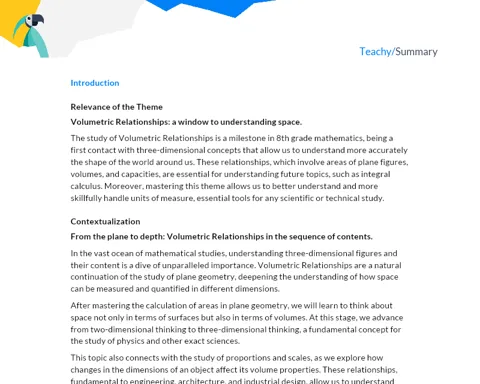Counting Natural Numbers Less Than 100 | Active Summary
Objectives
1. 🌟 Master the skill of counting natural numbers up to 100.
2. 🔍 Identify and count the quantity of elements in sets containing up to 100 items.
3. 🚀 Develop logical mathematical reasoning through practical and interactive activities.
Contextualization
Did you know that the skill of counting is one of the first forms of mathematics that people learn? From a young age, we use this skill to understand quantities, organize objects, and even have fun with games. Counting to 100 is an important milestone in the development of mathematical skills and is essential for many everyday activities, such as counting money or measuring quantities. In this lesson, we will explore this essential skill in a super fun and interactive way!
Important Topics
Activity 1 - The Treasure of One Hundred Numbers
This activity focuses on developing the skill of counting and identifying missing numbers in a sequence up to 100. Students work in groups to analyze a collection of numbered items, identifying numbers that are absent. This practical activity not only reinforces sequential counting but also stimulates logical reasoning and collaboration among students.
-
Development of counting skills in a game context, making learning more engaging.
-
Encouragement of teamwork, where students need to communicate and cooperate to achieve a common goal.
-
Reinforcement of understanding numerical sequences and the importance of each number in a series.
Activity 2 - The Number Race
In this dynamic activity, students participate in a race where they need to count out loud and jump over numbered lines from 1 to 100. This physical activity integrates learning and movement, helping students engage actively with the content while practicing counting and memorizing natural numbers.
-
Integration of physical movement with mathematical learning for better retention of numbers.
-
Promotion of physical and mental health, as exercise can increase concentration and memory.
-
Practice of rapid and accurate counting, essential for numerical fluency.
Activity 3 - Assembling the Number Puzzle
Students work in groups to assemble a puzzle that forms a number line from 1 to 100. This activity helps visualize the complete numerical sequence, promoting a deeper understanding of the order of numbers and the continuity of the numerical sequence.
-
Physical visualization of the numerical sequence, facilitating understanding of the order and continuity of numbers.
-
Development of fine motor skills and problem-solving abilities during the assembly of the puzzle.
-
Fostering the ability to work collaboratively and to communicate mathematical ideas clearly.
Key Terms
-
Counting: The act of sequentially adding one number, usually starting from one, to determine the quantity of items in a set.
-
Natural Number: Any positive whole number, excluding zero. In this context, we are focusing on the numbers from 1 to 100.
-
Numerical Sequence: A succession of numbers in a specific order. In this case, we are working with the sequence of natural numbers from 1 to 100.
To Reflect
-
How can the skill of counting numbers help in organizing daily life?
-
Why is it important to know how to count quickly and accurately?
-
In what ways can practical activities in mathematics improve understanding and memory of mathematical concepts?
Important Conclusions
-
Today we learned about the importance and the skill of counting natural numbers up to 100, a fundamental basis for many aspects of daily and academic life.
-
We explored different practical activities that not only helped understand the numerical sequence better but also work as a team and solve problems creatively.
-
Understanding and applying the counting of numbers helps us organize, plan, and execute daily tasks more efficiently, showing how mathematics is intrinsically linked to our everyday life.
To Exercise Knowledge
Create your own number puzzle with pieces of paper and challenge your family to assemble it in increasing order. Practice counting down from 100 to 1 to improve your numerical fluency. Use objects at home, like fruits, to count and group them in tens, visualizing the quantity in different ways.
Challenge
Fruit Seller Challenge: Imagine you are a fruit seller. Use your knowledge to count and organize fruits into groups of 10 until you reach 100. Then, try to sell your imaginary fruits to your family, explaining how you organized and counted the fruits to facilitate the sale!
Study Tips
-
Practice counting with online games or apps that encourage math practice in a playful and interactive way.
-
Try teaching someone younger or a classmate to count to 100; teaching is a great way to solidify what you've learned.
-
Create numbered cards from 1 to 100 and use them daily to organize your study space, which will help you memorize the numerical sequence.



